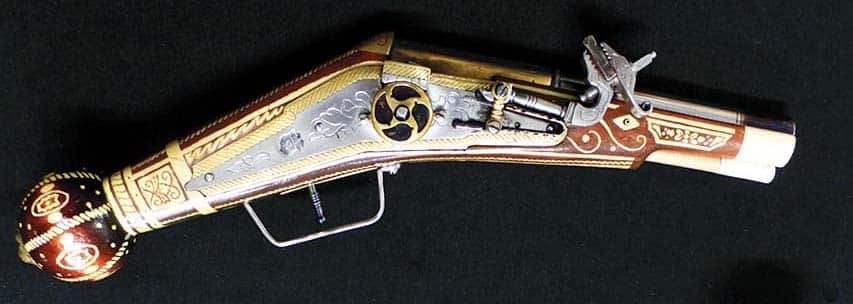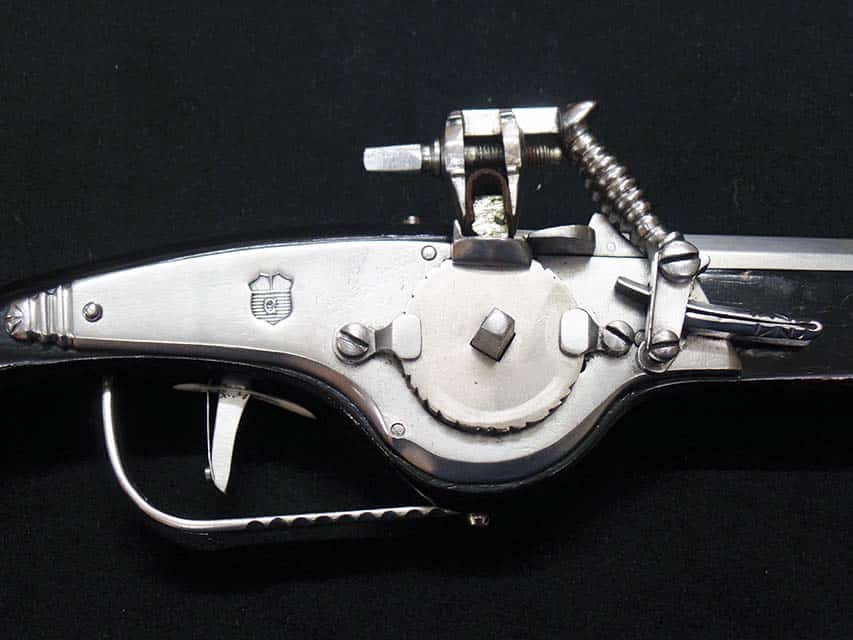By Kyle Shea
When firearms first appeared, a match was needed to light a pan of powder to shoot the metal ball. This had many setbacks, including making sure the match was dry. Rain and snow could easily put out the match, or the match could easily just go out. In the 1500s, a possible replacement arrived. This was the wheel-lock musket. It was more expensive than the matchlock, but it was easier to use and could be carried and shot on horseback and with one hand.
The way a wheel-lock works is similar to how modern lighters work. A piece of pyrite is held against a turning wheel. The wheel is attached to a spring, so a spanner wrench is used to turn the wheel back. When the trigger is pulled, the wheel turns against the pyrite, setting off sparks that enter a pan of gunpowder. Many of the wheel-locks are very well decorated and are works of art. Symbols of royalty and golden flowers cover many of these amazing firearms.

The wheel-lock was popular with wealthy land owners and was mostly used for hunting. However, it was used in war and was popular with knights. It was widely used by mounted troops in a number of conflicts throughout the 1500s and the 1600s, including the English Civil War, the Ottoman Wars and the intense Thirty Years War. It was also popular with assassins, because you could hide it in your clothing and pull it out to shoot when the time was right. This is how William Prince of Orange was killed in 1584, one of the first heads of state to be assassinated by a pistol.
One of the problems with the wheel-lock was that if you lost the spanner wench, you would be unable to reload and shoot. As mentioned before, it was an expensive weapon, so only the wealthy could afford it. The Matchlock was less expensive, so it continued to dominate the battlefield until the flintlock became more readily available. Also, there were times when the pyrite would not light, and the powder still needed to be dry.

Up-close view of the wheel lock of a pistol used in “Mary Queen of Scots.”
In the photos are two wheel-lock pistols used in the films. The first photo shows a well-decorated wheel-lock. I was unable to find the movie, but it is supposed to be a film about Queen Elizabeth I. The gun is beautiful to look at, and comes in a case that contains a couple of other accessories, including a flask for holding gunpowder.
The other pistol is from the film “Mary Queen of Scots.” It is not as ornate as the other ones, but it is bigger, well-polished and looks more affordable. The words, “Carl Schmidt Me Fecit” (essentially “Carl Schmidt made me”) are engraved on the top, and a shield with a “C” is placed above the trigger. As for the movie, it is not that good. It did not win over critics, and it did poorly at the box office. There are a lot of historical inaccuracies, and the film is slow. The main leads, Saoirse Ronan and Margot Robbie, do a good job with their performances, but that is all I can praise. If you enjoy the film that is okay; feel free to do so.
| This article first appeared in Small Arms Review V23N6 (JUNE/JULY 2019) |












